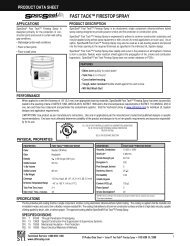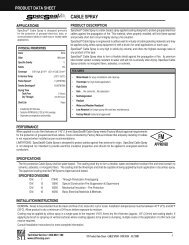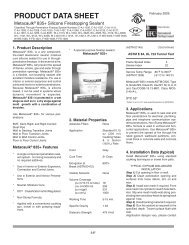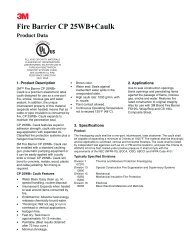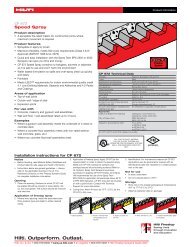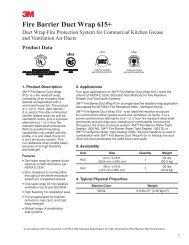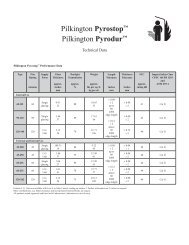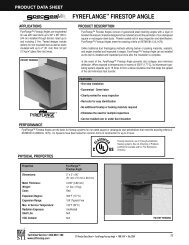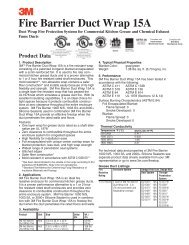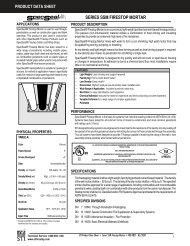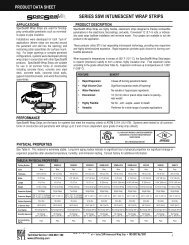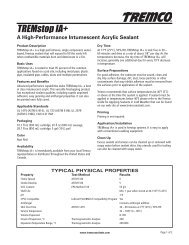Fire Resistance of Gypsum Board Wall Assemblies - FireProtection411
Fire Resistance of Gypsum Board Wall Assemblies - FireProtection411
Fire Resistance of Gypsum Board Wall Assemblies - FireProtection411
Create successful ePaper yourself
Turn your PDF publications into a flip-book with our unique Google optimized e-Paper software.
Construction Technology Update No. 2<br />
<strong>Fire</strong> <strong>Resistance</strong> <strong>of</strong> <strong>Gypsum</strong><br />
<strong>Board</strong> <strong>Wall</strong> <strong>Assemblies</strong><br />
by M.A. Sultan and G.D. Lougheed<br />
This Update discusses the importance <strong>of</strong> various factors in achieving the required<br />
fire resistance for walls in multi-family dwellings. The information is based on<br />
results from an extensive industry-supported research project carried out by the<br />
National Research Council’s Institute for Research in Construction (IRC). 1<br />
Researchers at IRC set out<br />
to determine how the sound<br />
transmission class (STC) and<br />
the fire-resistance ratings<br />
(FRR) <strong>of</strong> insulated and noninsulated<br />
gypsum board wall<br />
assemblies would be affected<br />
by two different kinds <strong>of</strong><br />
changes. First, new requirements<br />
in the 1990 National<br />
Building Code <strong>of</strong> Canada<br />
(NBC) increased the STC<br />
between dwelling units from<br />
45 to 50 and second, the<br />
standard regulating the use<br />
<strong>of</strong> gypsum board called for<br />
the removal <strong>of</strong> minimum<br />
density requirements for<br />
gypsum board.<br />
Whole systems, not just<br />
materials, were tested to get<br />
a complete picture <strong>of</strong> how<br />
Figure 1. A gypsum board wall various parameters affect<br />
assembly undergoing testing in IRC’s acoustic and fire performance,<br />
propane-fired vertical furnace. as the achievement <strong>of</strong> high<br />
acoustic performance may<br />
have negative implications for fire performance,<br />
or the other way around.<br />
In the fire testing, the assemblies were<br />
exposed to heat in a propane-fired vertical<br />
furnace. Each assembly was given a fireresistance<br />
rating based on the time it took<br />
to fail in any way — structurally, or by<br />
exceeding a specified temperature, or<br />
permitting the penetration <strong>of</strong> flames or<br />
gases hot enough to ignite cotton waste. 2<br />
Influence <strong>of</strong> Various Factors on<br />
<strong>Fire</strong> <strong>Resistance</strong><br />
The influence <strong>of</strong> the various parameters<br />
(see box, page 2) are as follows:<br />
Type <strong>of</strong> <strong>Gypsum</strong> <strong>Board</strong><br />
<strong>Gypsum</strong> board with glass fibre in the gypsum<br />
core provides better fire resistance than<br />
gypsum board without glass fibre. This is<br />
due to the fact that the lighter the gypsum<br />
board is, the more easily it cracks; and the<br />
more cracks it has, the more susceptible it<br />
is to disintegration in a fire. The glass fibre<br />
in the core helps keep the gypsum board<br />
together. When there is more than one<br />
layer <strong>of</strong> gypsum board on each side <strong>of</strong> the<br />
assembly, the presence <strong>of</strong> glass fibre in the<br />
gypsum core has less effect.<br />
In load-bearing assemblies with lightweight<br />
regular gypsum board, the presence<br />
<strong>of</strong> the glass fibre in the gypsum board core<br />
increased the fire-resistance rating <strong>of</strong> an<br />
assembly with a single layer <strong>of</strong> gypsum<br />
board (with a density <strong>of</strong> 7.35 kg/m 2 ) on<br />
each side by 25 percent compared to the<br />
same single-layer assembly with no glass<br />
fibre in the gypsum core (with a density<br />
<strong>of</strong> 7.27 kg/m 2 ).<br />
Density <strong>of</strong> <strong>Gypsum</strong> <strong>Board</strong><br />
The fire resistance <strong>of</strong> wall assemblies with<br />
regular (standard) gypsum board increases as<br />
the density <strong>of</strong> the gypsum board increases.<br />
When non-load-bearing assemblies with<br />
a double layer <strong>of</strong> regular gypsum board on<br />
each side (2x2) were tested, an assembly<br />
with gypsum board <strong>of</strong> a higher density<br />
(7.82-kg/m 2 ) provided a slightly better
The project investigated the effects <strong>of</strong> the following parameters on the fire resistance <strong>of</strong> 22 wall assemblies:<br />
Symmetrical and asymmetrical arrangements <strong>of</strong> gypsum board. Three different wall assembly<br />
arrangements on wood studs and on lightweight-steel studs were studied:<br />
• symmetrical installation (1x1) — one layer <strong>of</strong> gypsum board on both the fire-exposed and<br />
unexposed sides<br />
• asymmetrical installation (1x2) — one layer <strong>of</strong> gypsum board on the exposed side and two layers<br />
<strong>of</strong> gypsum board on the unexposed side. For all tests performed on asymmetrical assemblies, the<br />
side <strong>of</strong> the wall with the single layer <strong>of</strong> gypsum board was exposed to fire since this is the more<br />
conservative orientation.<br />
• symmetrical installation (2x2) — two layers <strong>of</strong> gypsum board on each side.<br />
Type, density and thickness <strong>of</strong> gypsum board. Two gypsum board types were evaluated:<br />
• Type-X, which is a generic name used to designate gypsum board with a specially formulated core<br />
that provides a greater fire resistance than regular gypsum board. Both 12.7-mm and<br />
15.9-mm thicknesses were tested.<br />
• Regular gypsum board, 12.7 mm thick with densities (mass per unit area) <strong>of</strong>:<br />
7.82 kg/m 2 with no glass fibre in the gypsum core<br />
7.35 kg/m 2 with glass fibre in the gypsum core. (This lightweight gypsum board was<br />
manufactured specifically for this project.)<br />
7.27 kg/m 2 with no glass fibre in the gypsum core.<br />
Both types conformed to CAN/CSA.A82.27-M91, the standard regulating the use and application <strong>of</strong><br />
gypsum board.<br />
Resilient channel installation. A resilient channel is a long strip <strong>of</strong> thin steel with a stepped configuration<br />
where one vertical leg is attached to the stud and the other to the gypsum board; it has a total<br />
width <strong>of</strong> about 25 mm. Resilient channels were attached horizontally on either the fire-exposed side<br />
or the unexposed side, spaced at 400 mm on centre perpendicular to the wood studs. The gypsum<br />
board was then attached to the resilient channels. The purpose <strong>of</strong> these channels is to provide a<br />
discontinuity so that sound is less able to be transmitted through the assembly.<br />
Type <strong>of</strong> insulation. Glass fibre, rock fibre, and cellulose fibre insulation were tested.<br />
Stud type and arrangement. The wood-stud walls tested included both load-bearing and non-load-bearing<br />
assemblies, although all steel-stud walls tested were non-load-bearing. The wood-stud configurations<br />
included single, double and staggered rows. A single plate was used for assemblies with single and<br />
staggered studs and double plates were used for assemblies with double studs.<br />
fire-resistance rating than an assembly<br />
with gypsum board <strong>of</strong> a lower density<br />
(7.35-kg/m 2 ).<br />
Number and Arrangement <strong>of</strong> <strong>Gypsum</strong><br />
<strong>Board</strong> Layers<br />
Increasing the number <strong>of</strong> layers on each<br />
side from one to two improves the FRR.<br />
Using an asymmetrical assembly (1x2),<br />
however, <strong>of</strong>fers no particular advantage<br />
over that <strong>of</strong> a symmetrical (1x1) assembly<br />
for a load-bearing wall assembly since it<br />
must be assumed that the fire will start on<br />
the single-layer (weakest) side. 3 Thus, the<br />
fire-resistance rating for an asymmetrical<br />
(1x2) assembly is comparable to that <strong>of</strong> the<br />
symmetrical (1x1) assembly. While the<br />
asymmetrical arrangement can help achieve<br />
a higher STC, it does not improve the FRR.<br />
In load-bearing (wood) assemblies with<br />
glass fibre insulation in the wall cavity and<br />
with resilient channels, a symmetrical<br />
assembly with a double layer <strong>of</strong> 12.7-mm<br />
thick gypsum board (2x2) provided a<br />
55-percent increase in the FRR as compared<br />
to an asymmetrical (1x2) assembly.<br />
Thickness <strong>of</strong> <strong>Gypsum</strong> <strong>Board</strong><br />
Increasing the thickness <strong>of</strong> the gypsum<br />
board layer does not appear to improve the<br />
FRR when resilient channels are present on<br />
the single-layer side.<br />
When load-bearing asymmetrical assemblies<br />
(1x2) with glass fibre insulation in the<br />
wall cavity and resilient channels located<br />
on the side with the single layer <strong>of</strong> gypsum<br />
board (fire-exposed side) were tested,<br />
changing the Type-X gypsum board thickness<br />
2
89 mm<br />
Basic <strong>Wall</strong> Configurations Tested<br />
400 mm 2 layers<br />
1 layer<br />
1 layer<br />
both sides<br />
1 layer 2 layers<br />
both sides<br />
2 layers<br />
a) b) c) d)<br />
<strong>Wall</strong> construction 1. Single wood studs<br />
• one or two layers <strong>of</strong> gypsum board<br />
• 38-mm x 89-mm studs<br />
• with or without absorptive material<br />
• one or two layers <strong>of</strong> gypsum board<br />
102 mm<br />
400 mm 2 layers<br />
1 layer<br />
1 layer<br />
both sides<br />
1 layer 2 layers<br />
both sides<br />
2 layers<br />
a) b) c) d)<br />
<strong>Wall</strong> construction 2. Single wood studs with resilient channels<br />
• one or two layers <strong>of</strong> gypsum board<br />
• 38-mm x 89-mm studs<br />
• with or without absorptive material<br />
• resilient channels on one side<br />
• one or two layers <strong>of</strong> gypsum board<br />
400 mm<br />
1 layer<br />
140 mm<br />
1 layer<br />
both sides<br />
2 layers 2 layers<br />
both sides<br />
a) b) c)<br />
<strong>Wall</strong> construction 3. Staggered wood studs<br />
• one or two layers <strong>of</strong> gypsum board<br />
• two rows 38-mm x 89-mm<br />
studs staggered on common<br />
38-mm x 140-mm plate<br />
• with or without absorptive material<br />
• one or two layers <strong>of</strong> gypsum board<br />
400 mm<br />
1 layer<br />
153 mm<br />
1 layer<br />
both sides<br />
2 layers 2 layers<br />
both sides<br />
a) b) c)<br />
<strong>Wall</strong> construction 4. Staggered wood studs with resilient channels<br />
400 mm 1 layer<br />
203 mm<br />
1 layer<br />
both sides<br />
2 layers 2 layers<br />
both sides<br />
a) b) c)<br />
<strong>Wall</strong> construction 5. Double wood studs<br />
• one or two layers <strong>of</strong> gypsum board<br />
• two rows 38-mm x 89-mm<br />
studs staggered on common<br />
38-mm x 140-mm plate<br />
• with or without absorptive material<br />
• resilient channels<br />
• one or two layers <strong>of</strong> gypsum board<br />
• one or two layers <strong>of</strong> gypsum board<br />
• two rows 38-mm x 89-mm studs<br />
on separate 38-mm x 89-mm<br />
plates set 25 mm apart<br />
• with or without absorptive material<br />
• one or two layers <strong>of</strong> gypsum board<br />
64 mm<br />
600 mm<br />
1 layer<br />
both sides<br />
1 layer<br />
2 layers<br />
2 layers<br />
both sides<br />
a) b) c)<br />
<strong>Wall</strong> construction 6. Non-load-bearing steel studs (64mm)<br />
mm)<br />
• one or two layers <strong>of</strong> gypsum board<br />
• 31-mm x 64-mm<br />
non-load-bearing studs<br />
• with or without absorptive material<br />
• one or two layers <strong>of</strong> gypsum board<br />
92 mm<br />
600 mm<br />
1 layer<br />
both sides<br />
1 layer<br />
2 layers<br />
2 layers<br />
both sides<br />
a) b) c)<br />
<strong>Wall</strong> construction 7. Non-load-bearing steel studs (92mm)<br />
mm)<br />
• one or two layers <strong>of</strong> gypsum board<br />
• 31-mm x 92-mm steel studs<br />
• with or without absorptive material<br />
• one or two layers <strong>of</strong> gypsum board<br />
3
from 12.7 mm to 15.9 mm did not improve<br />
the fire-resistance rating. However, the fact<br />
that the fire-resistance rating did not<br />
improve with the increased thickness was<br />
mainly due to the ignition <strong>of</strong> the wood<br />
studs, caused by the penetration <strong>of</strong> the hot<br />
gases through the unprotected gypsum<br />
board butt joints. The gap between the<br />
studs and the gypsum board, created by the<br />
presence <strong>of</strong> the resilient channels, acted as<br />
a passageway through which the flames and<br />
hot gases spread after entering the cavity.<br />
When resilient channels are not used,<br />
the FRR <strong>of</strong> the same assembly can be<br />
improved from 25 minutes to 40 minutes<br />
by increasing the thickness <strong>of</strong> Type-X<br />
gypsum board from 12.7 mm to 15.9 mm.<br />
Installation <strong>of</strong> Resilient Channels<br />
In some cases, resilient channels can help to<br />
improve the fire resistance <strong>of</strong> the assembly;<br />
however, locating these channels on the<br />
single-layer side may significantly decrease<br />
the fire resistance <strong>of</strong> the assembly.<br />
In the asymmetrical (1x2) load-bearing<br />
assemblies with rock fibre insulation and<br />
resilient channels, the assembly with resilient<br />
channels installed on the double-layer side<br />
provided an 11-percent better fire-resistance<br />
rating than the same assembly with resilient<br />
channels installed on the single-layer (fireexposed)<br />
side.<br />
Type and Installation <strong>of</strong> Insulation<br />
Rock fibre insulation installed in the cavity<br />
<strong>of</strong> the wall assembly contributes significantly<br />
to its fire resistance. To maximize the<br />
benefits <strong>of</strong> insulation on the fire-resistance<br />
rating, it is important to install the insulation<br />
tightly between the studs.<br />
When the rock fibre insulation was<br />
installed in non-load-bearing assemblies in<br />
this way, it provided a 60-percent better fireresistance<br />
rating (100 minutes) than when it<br />
was installed loosely (60 minutes).<br />
In non-load-bearing asymmetrical (1x2)<br />
steel-stud assemblies, the installation <strong>of</strong><br />
either glass fibre or cellulose fibre (wet<br />
sprayed) insulation did not affect the fireresistance<br />
rating.<br />
Type <strong>of</strong> Stud<br />
The type <strong>of</strong> stud used in non-load-bearing<br />
walls is insignificant for assemblies with<br />
two layers <strong>of</strong> gypsum board on each side.<br />
In non-load-bearing assemblies with a<br />
double layer <strong>of</strong> gypsum board on each<br />
side (2x2), the assembly with wood studs<br />
provided a slightly better fire-resistance<br />
rating than assemblies with steel studs.<br />
(<strong>Assemblies</strong> with one layer <strong>of</strong> gypsum<br />
board on each side were not tested,<br />
because they did not meet STC criteria.)<br />
Arrangement <strong>of</strong> Studs<br />
There are no particular benefits in terms <strong>of</strong><br />
fire performance in using staggered studs<br />
or double studs instead <strong>of</strong> single studs,<br />
although these configurations can help<br />
enhance acoustic performance.<br />
Impact on the Industry<br />
As a result <strong>of</strong> this project and the related<br />
project by IRC’s Acoustics Laboratory on<br />
the STC <strong>of</strong> wall assemblies, the fire- and<br />
sound-resistance ratings <strong>of</strong> wall assemblies<br />
in Part 9 <strong>of</strong> the 1995 NBC have been<br />
updated and augmented from 17 listed<br />
assemblies in the 1990 Code to over 160<br />
in the 1995 Code.<br />
Drs. M.A. Sultan and G.D. Lougheed are senior<br />
fire research <strong>of</strong>ficers in the National <strong>Fire</strong><br />
Laboratory <strong>of</strong> the National Research Council’s<br />
Institute for Research in Construction.<br />
1. The project was supported by a consortium that<br />
included Canada Mortgage and Housing<br />
Corporation (CMHC), Canadian Sheet Steel<br />
Building Institute (CSSBI), Cellulose Insulation<br />
Manufacturers Association <strong>of</strong> Canada (CIMAC),<br />
Forintek Canada, <strong>Gypsum</strong> Manufacturers <strong>of</strong> Canada<br />
(GMC), IRC, Owens Corning Fiberglas Canada Inc.,<br />
and Roxul Inc.<br />
2. Since the NBC stipulates the required fire-resistance<br />
rating as well as the type <strong>of</strong> construction that<br />
an assembly used in a particular occupancy and<br />
location must have, and since there are no fireresistance<br />
ratings <strong>of</strong> less than 45 minutes included<br />
in the Code, assemblies that had a FRR <strong>of</strong> less than<br />
45 minutes were considered to have failed.<br />
3. However, for a non-load-bearing assembly, a 1x2<br />
assembly provides a better fire resistance than a 1x1<br />
assembly.<br />
© 1997<br />
National Research Council <strong>of</strong> Canada<br />
January 1997<br />
ISSN 1206-1220<br />
“Construction Technology Updates” is a series <strong>of</strong> technical articles containing<br />
practical information distilled from recent construction research.<br />
For more information, contact Institute for Research in Construction,<br />
National Research Council <strong>of</strong> Canada, Ottawa K1A 0R6<br />
Telephone: (613) 993-2607; Facsimile: (613) 952-7673; Internet: http://www.nrc.ca/irc




